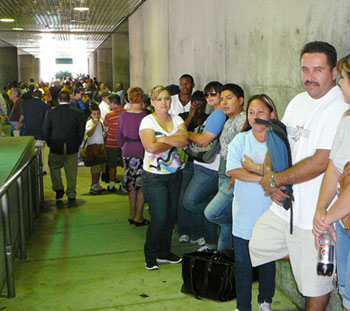Residential foreclosures
mount as economy sinks
 |
| Militant/Naomi Craine |
| More than 30,000 people lined up over five days at Los Angeles Convention Center to meet with bank representatives in hopes of adjusting their mortgages and keeping their houses. |
BY CINDY JAQUITH
Although major banks have announced a temporary freeze on some residential foreclosures, the White House is standing firmly against any program to guarantee working people a roof over their heads even as unemployment shows no sign of abatement.
More than 30,000 people lined up at the downtown convention center in Los Angeles September 30-October 4 in hopes of preventing foreclosure on their houses. Some camped overnight for a chance to meet with counselors and bank representatives in an attempt to modify their mortgages.
“I’ve talked to a lot of people who have the same story as me,” said Huy Nguyen as he waited to register for the event. “I applied three times for a loan modification in the last year and was rejected three times. They won’t give a reason.” Twenty percent of all foreclosures in August were in California, a state with 12.4 percent unemployment.
Nationwide, 95,000 people lost their houses to foreclosure in August, a 25 percent jump from a year ago and the highest monthly repossession rate on record, reports RealtyTrac.
Only 33,000 families qualified in August for temporary mortgage reduction under President Barack Obama’s Home Affordable Modification Program (HAMP), which guarantees that monthly mortgage payments cannot exceed 31 percent of the borrower’s income. But at the same time, 53,000 were dropped from HAMP because they couldn’t keep up even with a reduced mortgage.
Of $45.6 billion in money allocated by the Troubled Asset Relief Program for housing assistance in 2008, only $500 million has been spent.
Qualifying for a HAMP mortgage reduction will get even harder starting November 1, when the program will no longer include unemployment benefits in its calculation of potential borrowers’ income.
Many of those foreclosed have been forced to move in with family or friends, increasing the number of multifamily households by 11.6 percent in the last two years, according to the Census Bureau.
Rowena Suckow, a 48-year-old school bus driver, told a more and more familiar story to a national radio program. After losing her house back to the bank, she and her son moved in with her mother, who lives in a trailer in Florida. Suckow joins two sisters and a brother who also now live with relatives.
There is also an increase in people renting apartments because they have lost their houses. The increased demand has allowed landlords to jack up the rents by 0.6 percent, reported the Los Angeles Times. “We are getting more rent every time we either renew the lease or a new resident comes in,” gushed Jeffrey Friedman, chief executive of Associated Estates Realty Corp.
Citing questions about the validity of some of its eviction documents, Bank of America put a hold on foreclosures in all 50 states October 8. JPMorgan Chase, the GMAC Mortgage unit of Ally Bank, and PNC Financial Services froze foreclosures in 23 states. Some liberal Democrats and union officials called for a national moratorium on foreclosures.
The Wall Street Journal, however, warned that such a move would just delay the bottoming out of the mortgage crisis and drive house and apartment prices down further, affecting the entire economy. The White House agreed with the Journal. President Barack Obama’s adviser, David Axelrod, said, “There are in fact valid foreclosures that probably should go forward.”
Asked at a September 28 speech in New Mexico what the government was doing to protect veterans from foreclosure, Obama replied, “There’s no government program where we can just make sure that whoever is losing their home that we can just pick up the tab.” The president called for “a traditional, more common sense way of thinking about housing which is, if you want a house, you got to save for a while.”
A study published in the October American Sociological Review found that lenders deliberately steered Blacks into subprime loans where their mortgage rate would eventually soar far beyond their ability to pay. Blacks having a similar credit rating to whites and putting down the same deposit were more often offered subprime loans, even if they qualified for better terms. From 1993 to 2000 the number of subprime loans going to African Americans or Latinos rose from 2 percent to 18 percent.
Naomi Craine from Los Angeles contributed to this article.
No comments:
Post a Comment
Comments